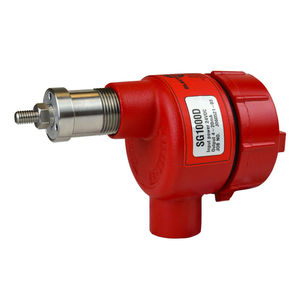
Monitoring control system SG1000C
Add to favorites
Compare this product
Characteristics
- Function
- monitoring
Description
Features
• Shaft position feedback — 0° to 359°
• Precisely measures repetitive single
turn rotary movement
• Works on powered or manually driven shafts
• Non-volatile memory — retains monitored shaft position
in the event of a power loss
• Interface with PLC or use the optional PM500 Process
Meter as a remote display unit
• Class I, Div I (C, D) Class II, Div I (E, F, G)
The SG1000C is housed in a compact and rugged explosion-proof, NEMA 4X enclosure, the SG1000C is an encoder-based position sensor providing a 4-20 mA output and is used to measure processes that have a repetitive single turn clockwise or counterclockwise rotary movement.
Once programmed, the SG1000C outputs a 4 mA DC signal when the encoder is at the beginning of its rotation (0 degrees) and outputs a 20 mA DC signal when the encoder is at the full turn position (359 degrees). When the encoder is at any position (between 0 degrees and 359 degrees) the SG1000C outputs a signal that is proportionally between 4 and 20 mA. Typically the SG1000C is used to sense the chute position of a rotary grain distributor enabling the end-user to very accurately monitor shaft position, ensuring accurate process control.
The optional PM500 Process Meter can be used as a remote display and can provide the +24 VDC output power for the SG1000C. It can display the 4-20 mA signal in any user units, including as a percentage between fully-closed (0%) to fully-open (100%) allowing the gate or valve to be accurately positioned when regulating the flow of a product or mixing products.
Catalogs
SG1000C
2 Pages
Product Brochure
28 Pages
*Prices are pre-tax. They exclude delivery charges and customs duties and do not include additional charges for installation or activation options. Prices are indicative only and may vary by country, with changes to the cost of raw materials and exchange rates.




